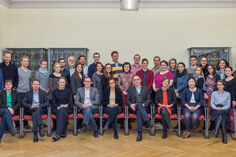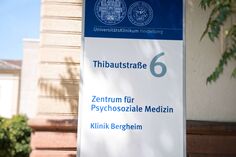Publikationen - Neurokognition
2015 | 2014 | 2013 | 2012 | 2011 | 2010 und älter
Publikationen
2010 und älter
Buchbeiträge
Bachmann, S., Weisbrod, M., & Mundt, C. (2005). Schizophrenie. In Senf, W., Broda, M. (Hrsg.) Praxis der Psychotherapie (3. Aufl., pp. 483-492). Stuttgart, New York: Georg Thieme Verlag. Behandlungskonzepte psychischer Erkrankungen (pp. 63-81). Heidelberg: Wolfsbrunnen-Verlag.
Bender S., Weisbrod, M., & Resch, F. (2009). Functional and Structural Endophenotypes. In Ritsner M.S. (Eds.) Handbook of Neuropsychiatric Biomarkers, Endophenotypes, and Genes. Promises, Advances, and Challenges (pp. 67-85). Heidelberg, New York: Springer.
Kaiser, S., Aschenbrenner, S., Pfüller, U., Roesch-Ely, D., & Weisbrod, M. (2010). Wiener Testsystem: Response Inhibition. Mödling: Schuhfried.
Kaiser, S., Mundt, C., & Weisbrod, M. (2003). Störung der Exekutiven Kontrollfunktionen bei depressiven Patienten - Implikationen für die Psychotherapie. In Schiepeck, G. (Hrsg.) Neurobiologie der Psychotherapie (pp. 453-468). Stuttgart: Schattauer GmbH.
Kiefer, M., Weisbrod, M., I. Kern, & Spitzer, M. (1996). Hirnelektrische Aktivität beim Zugriff auf das semantische Gedächtnis: Ereigniskorrelierte Potentiale in einem semantischen Bahnungsparadigma. In Kluwe, R.W., May, M. (Hrsg.) Proceedings der 2. Fachtagung der Gesellschaft für Kognitionswissenschaften (pp. 65-67). Hamburg: Universität Hamburg.
Kiefer, M., Weisbrod, M., Kern, I., Maier, S., & Spitzer, M. (1997). The effect of semantic distance on event-related potentials in normal subjects and schizophrenic patients. In Witte, H. et al. (Hrsg.) Quantitative and Topological EEG and MEG Analysis (pp. 169-171). Jena: Druckhaus Mayer Verlag GmbH.
Koch, E., Weisbrod, M., Ehlers, F., Resch, F., & Mundt, C. (2004). Das Heidelberger Frühbehandlungszentrum (FBZ) ein Zentrum für junge Menschen in Krisen. In Hippius, H. (Hrsg.) Universitätskolloquien zur Schizophrenie (pp. 32-34). Darmstadt: Steinkopfverlag.
Resch, F., & Weisbrod, M. (2009). Schizophrene, wahnhafte und andere psychotische Störungen. In Fegert, J.M., Streeck-Fischer, A., Freyberger, H.J. (Hrsg.) Adoleszenzpsychiatrie. Psychiatrie und Psychotherapie der Adoleszenz und des jungen Erwachsenenalters (pp. 241-261). Stuttgart, Berlin: Schattauer.
Sauer, H., & Weisbrod, M. (2000). Schizophrenie: Störungen der Hemisphärenlateralisierung. In Helmchen, H., et al. (Hrsg.) Psychiatrie der Gegenwart (4. Auflage, pp. 105-116). Heidelberg, Springer.
Schröder, J., & Weisbrod, M. (2006). Schizophrene Psychosen. In Hampel, H., Rupprecht, R. (Hrsg.) Roter Faden - Psychiatrie und Psychotherapie (pp. 349-389). Stuttgart: Wissenschaftliche Verlagsgesellschaft.
Thomas C., Hestermann, U., Oster, P., Mundt, C., & Weisbrod, M. (2008). Delir bei Demenz - Diagnostische Möglichkeiten und Fallstricke. In Adler, G., Gutzmann, G., Drach, L. (Hrsg.) Seelische Gesundheit und Lebensqualität im Alter - Ressourcen, Kompetenzen, Behandlungsstrategien (pp. 152-159). Stuttgart, Berlin: W. Kohlhammer.
Weisbrod, M. (2004). Die Heidelberger Zwillingsuntersuchung zur Schizophrenie. In Hippius, H. (Hrsg.) Universitätskolloquien zur Schizophrenie (pp. 15-21). Darmstadt: Steinkopfverlag.
Weisbrod, M., & Mundt, C. (1999). Schizophrenie. In Senf, W., Broda, M. (Hrsg.) Praxis der Psychotherapie (3. Aufl., pp. 440-447). Stuttgart, New York: Georg Thieme Verlag.
Weisbrod, M., & Mundt, C. (2007). Desaktualisierung und Realitätskontrolle. In Herpertz, S., Caspar, F., Mundt, C. (Hrsg.) Störungsorientierte Psychotherapie (pp. 241-257). München: Elsevier, Urban & Fischer Verlag.
Weisbrod, M., & Oelkers-Ax, R. (2006). Psychology in Adolescense. In Malaka, R., Spitzer M. (Hrsg.) Course Material, Interdisciplinary College, Focus Theme: Learning (pp. 517-523). Heidelberg, Ulm: Günne.
Weisbrod, M., Aschenbrenner, S., Kaiser, S., Pfueller, U., & Roesch-Ely, D. (2010). Behandlung kognitiver Defizite der Schizophrenie. In N. H. Bergemann (Ed.), Aktuelle Behandlungskonzepte psychischer Erkrankungen. (pp. 63-81). Heidelberg: Wolfsbrunnen-Verlag.
Weisbrod, M., Kiefer, M., Maier, S., Winkler, S., Hill, H., & Spitzer, M. (1997). Difficulty of the auditory oddball paradigm determines P300 topography in schizophrenic patients. In Witte, H. et al. (Hrsg.) Quantitative and Topological EEG and MEG Analysis (pp. 158-160). Jena: Druckhaus Mayer Verlag GmbH.
Weisbrod, M., Maier, S., Kiefer, M., & Spitzer, M. (1996). Ereigniskorrelierte Potentiale bei semantischen Sprachverarbeitungsprozessen schizophrener Patienten. In R.W. Kluwe, May, M. (Hrsg.) Proceedings der 2. Fachtagung der Gesellschaft für Kognitionswissenschaften (190-192). Hamburg: Universität Hamburg.
Weisbrod, M., Pfueller, U., Roesch-Ely, D., & Schröder, J. (2010). Schizophrenia. In R. A. H. Carlstedt (Ed.), Handbook of Integrative Clinical Psychology, Psychiatry, and Behavioral Medicine: Perspectives, Practices, and Research (pp. 589-604). New York, London: Springer
Weisbrod, M., Pfüller, U., Roesch-Ely D., & Schroeder J. (2010). Schizophrenia. In Carlstedt R. A (Hrsg.) Handbook of Integrative Clinical Psychology, Psychiatry, and Behavioral Medicine; Perspectives, Practices, and Research (pp. 589-604). New York, London: Springer.
Zeitschriftenartikel
Nikendei, C., Friederich, H.-C., Schild, S., Aghotor, J., Pfüller, U., Moritz, S., Weisbrod, M.,& Roesch-Ely, D. (2010). Metacognitive training for patients with schizophrenia (MCT): Feasibility and preliminary evidence for its efficacy. Journal of Behavior Therapy and Experimental Psychiatry, 41(3), 207-211.
Bachmann, S., Weisbrod, M., Röhrig, M., Schröder, S., Thomas, Ch., Scherg, M., & Rupp, A. (2010). MEG does not reveal impaired sensory gating in first-episode schizophrenia. Schizophrenia Research, 121, 131-138.
Backenstraß, M., Kronmüller, K.T., Schwarz, T., Reck, C., Karr, M., Kocherscheidt, K., Schifferer, E., Niethammer, R., Weisbrod, M., Mundt, Ch., & Fiedler, P. (2001). Kognitive Verhaltenstherapie in und mit Gruppen - Ein Behandlungsprogramm für depressive Patienten in stationärer Behandlung. Verhaltenstherapie, 11, 305-311.
Bender S, Oelkers-Ax, R., Bornfleth, H., Resch, F., & Weisbrod, M. (2005). How do children prepare to react? Imaging maturation of motor preparation and stimulus-anticipation by late contingent negative variation. NeuroImage, 27(4), 737-752.
Bender, S., Basseler, K., Sebastian, I., Resch, F., Kammer, T., Oelkers-Ax, R., & Weisbrod, M. (2005). Electroencephalographic response to transcranial magnetic stimulation in children: Evidence for giant inhibitory potentials. Annals of Neurology, 58(1), 58-67.
Bender, S., Basseler, K., Sebastian, I., Resch, F., Kammer, T., Oelkers-Ax, R., & Weisbrod, M. (2004). Development of the electroencephalographic response to transcranial magnetic stimulation during childhood: Evidence for immature giant inhibitory potentials. International Journal of Psychophysiology, 54 (1-2), 89.
Bender, S., Becker, D., Oelkers-Ax, R., & Weisbrod, M. (2006). Cortical motor areas are activated early in a characteristic sequence during post-movement processing. NeuroImage, 32(1), 333-351.
Bender, S., Behringer, S., Freitag, C.M., Resch, F., & Weisbrod, M. (2010). Transmodal comparison of auditory, motor, and visual post-processing with and without short-term memory maintenance. Clinical Neurophysiology, 121, 2044-2064.
Bender, S., Hellwig, S., Resch, F., & Weisbrod, M. (2007). Am I safe? The ventrolateral prefrontal cortex 'detects' when an unpleasant event does not occur. NeuroImage, 38(2), 367-385.
Bender, S., Oelkers-Ax, R., Resch, F., & Weisbrod, M. (2004). Motor processing after movement execution as revealed by evoked and induced activity. Cognitive brain research, 21(1), 49-58.
Bender, S., Oelkers-Ax, R., Resch, F., & Weisbrod, M. (2006). Frontal lobe involvement in the processing of meaningful auditory stimuli develops during childhood and adolescence. NeuroImage, 33(2), 759-773.
Bender, S., Resch F., & M. Weisbrod. (2007). Which perspectives can endophenotypes and biological markers offer in the early recognition of schizophrenia? Journal of Neural Transmission, 114(9), 1199-1215.
Bender, S., Resch, F., Weisbrod, M., & Oelkers-Ax, R. (2004). Specific task anticipation versus unspecific orienting reaction during early contingent negative variation. Clinical Neurophysiology, 115(8), 1836-1845.
Bender, S., Resch, F., Weisbrod, M., R. Oelkers-Ax, R., & Hellwig, S. (2008). The topography of the scalp-recorded visual N700. Clinical Neurophysiology, 119(3), 587-604.
Bender, S., Weisbrod, M., Just, U.,Pfüller, U., Parzer, P., Resch, F., & Ölkers, R. (2002). Lack of age-dependent development of the contingent negative variation (CNV) in migraine children? Cephalagia, 22(2), 132-136.
Bender, S., Weisbrod, M., Resch, F., & Oelkers-Ax, R. (2007). Stereotyped topography of different elevated contingent negative variation components in children with migraine without aura points towards a subcortical dysfunction. Pain, 127(3), 221-233.
Einsiedel, v.R. W., Roesch-Ely, D., Diebold, K., Sartor, K., Mundt, C., & Bergemann, N. (2002). H(2)-histamine antagonist (famotidine) induced adverse CNS reactions with long-standing secondary mania and epileptic seizures. Pharmacopsychiatry, 35(4), 152-154.
Einsiedel, v.R., Berger, T., Unverricht, S., Weisbrod, M., & Hartmann, M. (2001). HIV-Patienten mit psychiatrischen Krankheiten: Behandlungsstrategien und Medikamenteninteraktionen. Der Nervenarzt, , 72(3), 204-215.
Goya-Maldonado, R., Walther, S., Simon, J., Stippich, Ch., Weisbrod, M., & Kaiser, S. (2010). Motor impulsivity and the ventrolateral prefrontal cortex. Psychiatry Research: Neuroimaging, 183, 89-91.
Grau, A.J., Brandt, T., Weisbrod, M., Niethammer, R., Forsting, M., Cantz, M., Vanier, M.T., & Harzer K. (1997). Adult Niemann-Pick disease type C mimicking features of multiple sclerosis. Journal of Neurology, Neurosurgery & Psychiatry, 63(4), 552.
Grau, A.J., Weisbrod, M., Hund, E., & Harzer, K. (2003). Morbus Niemann-Pick Typ C: Eine neurometabolische Erkrankung des intrazellulären Lipidtransports. Nervenarzt, 74(10), 900-905.
Hellwig, S., Weisbrod, M., Jochum, V., Rentrop, M., Unger, J., Walther, S., Haefner, K., Roth, A., Fiedler, P., & Bender S. (2008). Slow cortical potentials in human aversive trace conditioning. International Journal of Psychophysiology, 69(1), 41-51.
Hill, H., Batt, C., Maier, M., Weisbrod, M., & Kick, H. (1998). Light-therapy treatment and affective disorder with and without seasonality: Biological markers. German Journal of Psychiatry, 1, 41-52.
Hill, H., Ott, F., & Weisbrod, M. (2005). SOA-dependent N400 and P300 semantic priming effects using pseudoword primes and a delayed lexical decision. International Journal of Psychophysiology, 56(3), 209-221.
Hill, H., Ott, F.,Herbert, C. & Weisbrod, M. (2006). Response execution in lexical decision tasks obscures sex specific lateralization effects in language processing: Evidence from event-related potential measures during word reading. Cerebral Cortex, 16(7), 978-989.
Hill, H., Strube, M., Roesch- Ely, D., & Weisbrod, M. (2002). Automatic vs. controlled processes in semantic priming - differentiation by event related potentials. International Journal of Psychophysiology, 44(3), 197-218.
Hill, H., & Weisbrod, M. (1999). The relation between asymmetry and amplitude of the P300 field in schizophrenia. Clinical Neurophysiology, 110(9), 1-7.
Irmen, L., Holt, D. V., & Weisbrod, M. (2010). Effects of role typicality on processing person information in German: Evidence from an ERP study. Brain Research, 1353, 133-144.
Just, U., Ölkers, R., Bender, S., Parzer, P., Ebinger, F., Weisbrod, M., & Resch, F. (2003). Emotional and behavioural problems in children and adolescents with primary headache. Cephalagia, 23(3), 206-213.
Kaiser, S., Kopka, M.L., Rentrop, M., Walther, S., Kornmüller, K., Olbrich, R., Weisbrod, M., & Stippich, C. (2010). Maintenance of real objects and their verbal designations in working memory. Neuroscience Letters, 469, 65-69.
Kaiser, S., Mundt, C., Weisbrod, M. (2005). Exekutive Kontrollfunktionen und neuropsychiatrische Erkrankungen - Perspektiven für Klinik und Forschung. Fortschritte der Neurologie, Psychiatrie, 73(8), 438-450.
Kaiser, S., Roth, A., Rentrop, M., Friederich, H.-C., Bender, S., & Weisbrod, M. (2008). Intra-individual reaction time variability in schizophrenia, depression and borderline personality disorder. Brain and Cognition, 66(1), 73-82.
Kaiser, S., Unger, J., Kiefer,M., Markela-Lerenc, J., Mundt, Ch., & Weisbrod, M. (2003). Executive control deficits in depression: event-related potentials in a Go/Nogo task. Psychiatry Research: Neuroimaging, 122(3), 169-184.
Kaiser, S., Walther, S., Nennig, E., Kronmüller, K., Mundt, Ch., Weisbrod, M., Stippich, C. & Vogeley, K. (2008). Gender specific strategy use and neural correlates in a spatial perspective taking task. Neuropsychologia, 46(10), 2524-2531.
Kaiser, S., Weiss, O., Hill, H., Markela-Lerenc, J., Kiefer, M., & Weisbrod, M. (2006). N2 event-related potential correlates of response inhibition in an auditory Go/Nogo task. International Journal of Psychophysiology, 61(2), 279-282.
Kaiser, S., & M. Weisbrod. (2007). Intentionality as a link between the neuropsychology and the symptoms of schizophrenia. Psychopathology, 40(4), 221-228.
Kiefer, M., Apel, A., & Weisbrod, M. (2002). Arithmetic fact retrieval and working memory in schizophrenia. Schizophrenia Research, 53(3): 219-227.
Kiefer, M., Martens, U., Weisbrod, M., Hermle, L., & Spitzer, M. (2009). Increased unconscious semantic activation in schizophrenia patients with formal thought disorder. Schizophrenia Research, 114, 79-83.
Kiefer, M., Marzinzik, F., Weisbrod, M., Scherg, M., & Spitzer, M. (1998). The time course of brain activations during response inhibition: Evidence from event-related potentials in a Go/NoGo-task. Neuroreport, 9(4): 765-770.
Kiefer, M., Weisbrod, M., & Spitzer, M. (1998). Zur funktionellen Neuroanatomie und Psychopathologie des semantischen Gedächtnisses. Psychologische Rundschau, 49(3), 132-143.
Kiefer, M., Weisbrod, M., Kern, I., Maier, S., & Spitzer, M. (1998). Right hemisphere activation during indirect semantic priming: evidence from event-related potentials. Brain and Language, 64(3), 377-408.
Kischka, U., Kammer, T., Maier S., Weisbrod, M., Thimm, M., & Spitzer, M. (1996). Dopaminergic modulation of semantic network activation. Neuropsychologia, 34(11), 1107-1113.
Markela-Lerenc, J., Ille, N., Kaiser, S., Fiedler, P., Mundt, C., & Weisbrod, M. (2003). Prefrontal-cingulate activiation during executive control: Which comes first? Cognitive Brain Research, 18(3), 278-287.
Markela-Lerenc, J., Kaiser, S., Fiedler, P., Weisbrod, M., & Mundt, C. (2006). Stroop performance in depressive patients: a preliminary report. Journal of Affective Disorders, 94(1-3), 261-267.
Markela-Lerenc, J., Schmidt-Kraepelin, C., Roesch-Ely, D., Mundt, C., Weisbrod, M., & Kaiser, S. (2009). Stroop interference effect in schizophrenic patients: An electrophysiological approach. International Journal of Psychophysiology, 71(3), 248-57.
Mohr A, Weisbrod, M., Schellinger, P., & Knauth, M. (2004). The similarity of brain morphology in healthy monozygotic twins. Cognitive Brain Research, 20(1), 106-110.
Mohr, A., Knauth, M., Weisbrod, M., Stippich, C., & Sartor, K. (2001). Die Ähnlichkeit von Zwillingsgehirnen. RöFo: Fortschritte auf dem Gebiet der Röntgenstrahlen und der Nuklearmedizin, 173(6), 515-521.
Mundt, Ch., & Weisbrod, M. (2004). Neuropsychologische Entsprechungen und therapeutische Konsequenzen des strukturdynamischen Modells. Fortschritte in der Neurologie und Psychiatrie, 72(1), 514-522.
Niethammer, R., Keller, A., & Weisbrod, M. (2000). Delirantes Syndrom als Lithium-Nebenwirkung bei normalen Lithium-Spiegeln. Psychiatrische Praxis, 27(6), 1-2.
Niethammer, R., Weisbrod, M., Schiesser, S., Schröder, J., & Sauer, H. (2000). Genetic influence on laterality in schizophrenia? A twin study of neurological soft signs. American Journal of Psychiatry, 157(2), 272-274.
Bender, S., Walther, S., Herzog, W., Zipfel, S., & Weisbrod, M. (2008). Anorexia nervosa: selective processing of food-related word and pictorial stimuli in recognition and free recall test. International Journal of Eating Disorders, 41(5), 439-447.
Nikendei, C., Waldherr, S., Schiltenwolf, M., Herzog, W., Röhrig, M., Walther, S., Weisbrod, M., Henningsen, P., & Hanel, G., (2009). Memory performance related to organic psychosocial illness attributions in somatoform pain disorder patients. Journal of Psychosomatic Research, 67, 199-206.
Oelkers-Ax, R., Bender, S., Just, U., Pfüller, U., Parze, P., Resch, F., & Weisbrod, M. (2004). Pattern-reversal visual-evoked potentials in children with migraine and other primary headache: evidence for maturation disorder? Pain, 108(3), 267-275.
Oelkers-Ax, R., Parzer, P., Resch, F., & Weisbrod, M., (2004). Maturation of early visual processing investigated by a pattern-reversal habituation paradigm is altered in migraine, Cephalalgia, 25(4), 280-289.
Oelkers-Ax, R., Schmitt, K., Bender, S., Möhler, E., Knauss, E., Resch, F., & Weisbrod, M. (2008). Longitudinal assessment of response preparation and evaluation in migraine gives evidence for deviant maturation. Cephalalgia, 28(3), 237-249.
Oknina, L., Wild-Wall, N., Oades, R., Juran, S., Röpke, B., Pfüller, U., Weisbrod, M., Chan, E., & Chen, E. (2005). Frontal and temporal sources of mismatch negativity in healthy controls, patients at onset of schizophrenia in adolescence and others at 15 years after onset. Schizophrenia Research, 76(1), 25-41.
Pfüller, U., Roesch-Ely, D., Mundt, C., & Weisbrod, M. (2010). Treatment of cognitive deficits in schizophrenia. Part 1: Diagnostic and psychological training. Nervenarzt, 81, 556-563.
Plaschke, K., Hill, H., Engelhardt, R., Thomas, C., Haken, v.R., Scholz, M., Kopitz, J., Bardenheuer, H., Weisbrod, M., & Weigand, A. (2007). EEG changes and serum anticholinergic activity measured in patients with delirium in the intensive care unit. Anaesthesia, 62(12), 1217-1223.
Renneberg, B., Theobald, E., Nobs, M., & Weisbrod, M. (2005). Autobiographical memory in borderline personality disorder and depression. Cognitive Therapy and Research, 29(3), 343-358.
Rentrop, M., Backenstrass, M., Jaentsch, B., Kaiser, S., Roth, A., Unger, J., Weisbrod, M., & Renneberg, B. (2008). Response inhibition in borderline personality disorder: performance in a Go/Nogo task. Psychopathology, 41(1), 50-57.
Rentrop, M., Rodewald, K., Roth, A., Simon, J., Walther, S., Fiedler, P., Weisbrod, M., & Kaiser, S. (2010). Intra-individual variability in high-functioning patients with schizophrenia. Psychiatry Research, 178, 27-32.
Roesch-Ely, D., Einsiedel, v.R., Kathöfer, S., Schwaninger, M., & Weisbrod, M. (2002). Myocarditis under treatment of quetiapine in a patient with paranoid schizophrenia: a case report. The American Journal of Psychiatry, 159(9), 1607-1608.
Roesch-Ely, D., Göhring, K., Gruschka, P., Pfüller, U., Burlon, M., & Weisbrod, M. (2006). Pergolide as adjuvant therapy in the treatment of negative and depressive symptoms in schizophrenia: a case study. Pharmacopsychiatry, 39(3), 115-116.
Roesch-Ely, D., Hornberger, E., Weiland, S., Hornstein, C., Parzer, P., Thomas, C., & Weisbrod, M. (2009). Do sex differences affect prefrontal cortex associated cognition in schizophrenia? Schizophrenia Research, 107(2-3), 255-261.
Roesch-Ely, D., Pfüller, U., Mundt, C., Müller, U., & Weisbrod, M. (2010). Treatment of cognitive deficits in schizophrenia. Part 2: Pharmacological strategies. Nervenarzt, 81, 564-576.
Roesch-Ely, D., Scheffel, H., Weiland, S., Schwaninger, M., Hundemer, H., Kolter, T., & Weisbrod, M. (2005). Differential dopaminergic modulation of executive control in healthy subjects. Psychopharmacology, 178(4), 420-430.
Roesch-Ely, D., Spitzer, M., Kaiser, S., Weisbrod, M., & Pfüller, U. (2010). Context Representation and thought disorder in schizophrenia. Psychopathology, 43, 275-284.
Roesch-Ely, D., Spitzer, M., & Weisbrod, M. (2003). Cognitive inhibition and thought disorder in schizophrenia. Psychopathology, 36(1), 23-32.
Roesch-Ely, D., Weiland, S., Scheffel, H., Schwaninger, M., Hundemer, H. P., Kolter, T., & Weisbrod, M. (2006). Dopaminergic modulation of semantic priming in healthy volunteers. Biological Psychiatry, 60(6), 604-611.
Roesch-Ely, D., Weiland, S., Scheffel, H., Schwanninger, M., Hundemer, H.-P., Kolter, T., & Weisbrod, M. (2006). Dopaminergic modulation of semantic priming in healthy volunteers. Biological Psychiatry, 60(6), 604-611.
Roth, A., Roesch-Ely, D., Bender, S., Weisbrod, M., & Kaiser, S. (2007). Increased event-related potential latency and amplitude variability in schizophrenia detected through wavelet-based single-trial analysis. International Journal of Psychophysiology, 66(3), 244-254.
Schnack, H, Picchioni, M., Murray, R., Weisbrod M., Sauer, H., Cannon, T., & Huttunen, M. (2010). Mapping reliability in multicenter MRI: voxed-based morphometry and cortical thickness. Human Brain Mapping, 31, 1967-1982.
Schnack, H.G., Haren, v. N.E.M., Hulshoff-Pol, H.E., Murray, R., Sauer, H., Cannon, T., Huttunen, M., Weisbrod, M., & Kahn, R.S. (2004). Reliability of brain volumes from multicenter MRI acquisition: a calibration study. Human Brain Mapping, 22(4), 312-320.
Schwaninger, M., Weisbrod, M., & Knepel, W. (1997). Progress in defining the mechanism of action of antidepressants: Across receptors and into gene transcription. CNS Drugs, 8(3), 237-243.
Schwaninger, M., Weisbrod, M., Schwab, S., Schröder, M., & Hacke, W. (1998). Hypothermia induced by atypical neuroleptics. Clinical Neuropharmacology, 21(6), 344-346.
Simon, J. Walther, S., Fiebach, C., Friederich, H., Stippich, C., Weisbrod, M., & Kaiser, S. (2010). Neural reward processing is modulated by approach-and avoidance-related personality traits. NeuroImage, 49, 1868-1874.
Simon, J., Biller, A., Walther, S., Roesch-Ely, D., Stippich, C., Weisbrod, M., Kaiser, S. (2010). Neural correlates of reward processing in schizophrenia-relationship to apathy and depression. Schizophrenia Research, 118, 154-161.
Spitzer, M., Böhler, S., Weisbrod, M., & Kischka, U. (1995). A neural network model of phantom limbs. Biological Cybernetics, 72, 197-206.
Spitzer, M., Brix, G., Kischka, U., Gückel, F., Bellemann, M.E., Kammer, T., Gass, A., Seyyedi, S., Weisbrod, M., Loose, R., & Schwartz, A. (1998). Functional magnetic resonance imaging of category-specific cortical activation: Evidence for semantic maps. Cognitive Brain Research, 6(4), 309-319.
Spitzer, M., Weisbrod, M., Winkler, S., & Maier, S. (1997). Ereigniskorrelierte Potentiale bei semantischen Sprachverarbeitungsprozessen schizophrener Patienten. Nervenarzt, 68(3), 212-225.
Stassen, H.H., Bridler, R., Hägele, S., Hergersberger, M., Mehmann, B., Schinzel, A., Weisbrod, M., & Scharfstetter, C. (2000). Schizophrenia and smoking: evidence for a common neurobiological basis? American Journal of Medical Genetics, 96(2), 173-177.
Stassen, H.H., Bridler, R., Hell, D., Weisbrod, M., & Scharfstetter, C. (2004). Ethnicity-independent genetic basis of functional psychoses. A genotype-to-phenotype approach. American Journal of Medical Genetics, 124B(1), 101-112.
Tanaka, J., Luu, S., Weisbrod, M., & Kiefer, M. (1999). Tracking the time course of object categorization using event-related potentials. Cognitive Neuroscience/Neuro Report, 10(4), 829-835.
Thomas C., Hestermann, U., Walther S., Pfueller U., Hack, M., Oster, P., Mundt, C., & Weisbrod, M. (2008). Prolonged activation EEG differentiates dementia with and without delirium in frail elderly patients. Journal of Neurology, Neurosurgery & Psychiatry, 79(2), 119-125.
Thomas, C., Hestermann U., Kopitz, J., Plaschke K., Oster P., Driessen M., Mundt C., & Weisbrod M. (2008). Serum anticholinergic activity and cerebral cholinergic dysfunction: An EEG study in frail elderly with and without delirium. BMC Neuroscience, 9(86), 1-10.
Thomas, C., vom Berg, I., Rupp, A., Seidl, U., Schröder, J., Roesch-Ely, D., Kreisel, S.H., Mundt, C., & Weisbrod, M. (2010). P50 gating deficits in Alzheimer dementia correlates to frontal neuropsychological function. Neurobiology of Aging, 31, 416-424.
Ugur, T., Weisbrod, M., Franzek, E., Pfüller, U., & Sauer, H. (2005). Olfactory impairment in monozygotic twins discordant for schizophrenia. European Archives of Psychiatry and Clinical Neuroscience, 255(2), 94-98.
Walther, S., Goya-Maldonado, R., Stippich, Ch., Weisbrod, M., & Kaiser, S. (2010). A supramodal network for response inhibition. NeuroReport, 21, 191-195.
Weisbrod, M. (2006). Schizophrene Psychosen: Chancen auf Selbstbestimmung erhalten. Klinikfenster, 2, 4-5.
Weisbrod, M. (2008). Gen-Umwelt-Interaktion bei schizophrenen Zwillingen. Bedeutung genetischer und nicht-genetischer Einflüsse auf die Erkrankung. Neuro-Psychiatrische Zeitung, 3, 13-14.
Weisbrod, M., Aschenbrenner, S., Kaiser, S., Pfüller, U., & Roesch-Ely, D. (2010). Behandlung kognitiver Defizite der Schizophrenie. In: N. Bergemann (Hrsg.) Aktuelle Behandlungskonzepte psychischer Erkrankungen. Dauner Dokumentation. Heidelberg: Wolfsbrunnen, S. 68-81.
Weisbrod, M., Hill, H., Niethammer, R., & Sauer, H. (1999). Genetic influence on auditory information processing in schizophrenia - P300 in monozygotic twins. Biological Psychiatry, 46(5), 721-725.
Weisbrod, M., Hill, H., Sauer, H., Niethammer, R., Guggenbühl, S., & Stassen, H. (2004). Nongenetic pathologic developments of brain wave patterns in monozygotic twins discordant and concordant for schizophrenia. American Journal of Medical Genetics, Neuropsychiatric genetics, 125B, 1-9.
Weisbrod, M., Kiefer, M., Hill, H., & Spitzer, M. (1999). Der Einsatz evozierter Potentiale zur Untersuchung von Störungen der auditorischen Informationsverarbeitung schizophrener Patienten. Nervenheilkunde, 18(3), 79-83.
Weisbrod, M., Koch, E., Eichstädter, R., Resch, F., & Mundt, C. (2005). Das Heidelberger Frühbehandlungszentrum: die gemeinsame Behandlung von adoleszenten Patienten durch Allgemeine und Kinder- und Jugendpsychiatrie. Psychotherapie im Dialog, 3(6), 314-317.
Weisbrod, M., Kölmel, H., Hättigand, H., & Lempert, T. (1992). The significance of vertical gaze palsy in the paramedian thalamic artery syndrome. Neuro-ophthalmology, 12(2), 85-90.
Weisbrod, M., M. Kiefer, F. Marzinzik, & Spitzer, M. (2000). Executive control is disturbed in schizophrenia: evidence from event-related potentials in a Go/Nogo task. Biological Psychiatry, 47(1), 51-60.
Weisbrod, M., Maier, S., Harig, S., Himmelsbach, U., & Spitzer, M. (1998). Lateralized semantic and indirect semantic priming effects in people with schizophrenia. British Journal of Psychiatry, 172, 142-146.
Weisbrod, M., Trage, J., Hill, H., Sattler, H., Maier, S., Kiefer, M., Grothe, J., & Spitzer, M. (1999). Emotional priming in depressive patients. German Journal of Psychiatry, 2, 19-47.
Weisbrod, M., Winkler, S., Maier, S., H. Hill, H., Roesch-Ely, D., Kiefer, M., & Spitzer, M. (1999). Electrophysiological correlates of direct versus indirect semantic priming in normal volunteers. Cognitive Brain Research, 8, 289-298.
Weisbrod, M., Winkler, S., Maier, S., Hill, H., Thomas C., & Spitzer, M. (1997). Left lateralized P300 amplitude deficit in schizophrenic patients depends on pitch disparity. Biological Psychiatry, 41(5), 541-549.
Weisser, R., Weisbrod, M., Roehrig, M., Rupp, A., Schröder, J., & Scherg, M. (2001). Is frontal lobe involved in the generation of auditory evoked P50? NeuroReport, 12(15), 3303-3307.
Zastrow, A., Kaiser, S., Stippich, C., Walther, S., Herzog, W., Tchanturia, K., Belger, A., Weisbrod, M., Treasure, J., & Friederich, H. (2009). Neural Correlates of Impaired Cognitive-Behavioral Flexibility in Anorexia Nervosa. American Journal of Psychiatry, 166(5), 608-616.




